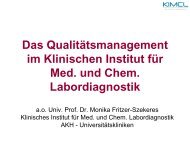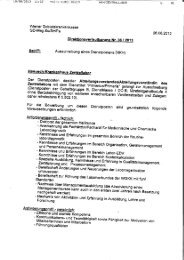Diagnosis and Classification of Diabetes Mellitus
Diagnosis and Classification of Diabetes Mellitus
Diagnosis and Classification of Diabetes Mellitus
You also want an ePaper? Increase the reach of your titles
YUMPU automatically turns print PDFs into web optimized ePapers that Google loves.
<strong>Diagnosis</strong> <strong>and</strong> <strong>Classification</strong><br />
practice, a large portion <strong>of</strong> the population<br />
with type 2 diabetes remains unaware <strong>of</strong><br />
their condition. Thus, it is conceivable<br />
that the lower sensitivity <strong>of</strong> A1C at the<br />
designated cut point will be <strong>of</strong>fset by the<br />
test’s greater practicality, <strong>and</strong> that wider<br />
application <strong>of</strong> a more convenient test<br />
(A1C) may actually increase the number<br />
<strong>of</strong> diagnoses made.<br />
Further research is needed to better<br />
characterize those patients whose glycemic<br />
status might be categorized differently<br />
by two different tests (e.g., FPG <strong>and</strong><br />
A1C), obtained in close temporal approximation.<br />
Such discordance may arise from<br />
measurement variability, change over<br />
time, or because A1C, FPG, <strong>and</strong> postchallenge<br />
glucose each measure different<br />
physiological processes. In the setting <strong>of</strong><br />
an elevated A1C but “nondiabetic” FPG,<br />
the likelihood <strong>of</strong> greater postpr<strong>and</strong>ial glucose<br />
levels or increased glycation rates<br />
for a given degree <strong>of</strong> hyperglycemia may<br />
be present. In the opposite scenario (high<br />
FPG yet A1C below the diabetes cut<br />
point), augmented hepatic glucose production<br />
or reduced glycation rates may<br />
be present.<br />
As with most diagnostic tests, a test<br />
result diagnostic <strong>of</strong> diabetes should be<br />
repeated to rule out laboratory error,<br />
unless the diagnosis is clear on clinical<br />
grounds, such as a patient with classic<br />
symptoms <strong>of</strong> hyperglycemia or hyperglycemic<br />
crisis. It is preferable that the same<br />
test be repeated for confirmation, since<br />
there will be a greater likelihood <strong>of</strong> concurrence<br />
in this case. For example, if the<br />
A1C is 7.0% <strong>and</strong> a repeat result is 6.8%,<br />
the diagnosis <strong>of</strong> diabetes is confirmed.<br />
However, there are scenarios in which results<br />
<strong>of</strong> two different tests (e.g., FPG <strong>and</strong><br />
A1C) are available for the same patient. In<br />
this situation, if the two different tests are<br />
both above the diagnostic thresholds, the<br />
diagnosis <strong>of</strong> diabetes is confirmed.<br />
On the other h<strong>and</strong>, when two different<br />
tests are available in an individual <strong>and</strong><br />
the results are discordant, the test whose<br />
result is above the diagnostic cut point<br />
should be repeated, <strong>and</strong> the diagnosis is<br />
made on the basis <strong>of</strong> the confirmed test.<br />
That is, if a patient meets the diabetes<br />
criterion <strong>of</strong> the A1C (two results $6.5%)<br />
but not the FPG (,126 mg/dl or 7.0<br />
mmol/l), or vice versa, that person should<br />
be considered to have diabetes. Admittedly,<br />
in most circumstance the “nondiabetic”<br />
test is likely to be in a range very<br />
close to the threshold that defines diabetes.<br />
Since there is preanalytic <strong>and</strong> analytic<br />
variability <strong>of</strong> all the tests, it is also possible<br />
that when a test whose result was above<br />
the diagnostic threshold is repeated, the<br />
second value will be below the diagnostic<br />
cut point. This is least likely for A1C,<br />
somewhat more likely for FPG, <strong>and</strong> most<br />
likely for the 2-h PG. Barring a laboratory<br />
error, such patients are likely to have test<br />
results near the margins <strong>of</strong> the threshold<br />
for a diagnosis. The healthcare pr<strong>of</strong>essional<br />
might opt to follow the patient<br />
closely <strong>and</strong> repeat the testing in 3–6<br />
months.<br />
The decision about which test to use<br />
to assess a specific patient for diabetes<br />
should be at the discretion <strong>of</strong> the health<br />
care pr<strong>of</strong>essional, taking into account the<br />
availability <strong>and</strong> practicality <strong>of</strong> testing an<br />
individual patient or groups <strong>of</strong> patients.<br />
Perhaps more important than which diagnostic<br />
test is used, is that the testing for<br />
diabetes be performed when indicated.<br />
There is discouraging evidence indicating<br />
that many at-risk patients still do not receive<br />
adequate testing <strong>and</strong> counseling for<br />
this increasingly common disease, or for its<br />
frequently accompanying cardiovascular<br />
risk factors. The current diagnostic criteria<br />
for diabetes are summarized in Table 3.<br />
<strong>Diagnosis</strong> <strong>of</strong> gestational diabetes<br />
GDM carries risks for the mother <strong>and</strong><br />
neonate. The Hyperglycemia <strong>and</strong> Adverse<br />
Pregnancy Outcomes (HAPO) study<br />
(11), a large-scale (;25,000 pregnant<br />
women) multinational epidemiologic<br />
study, demonstrated that risk <strong>of</strong> adverse<br />
maternal, fetal, <strong>and</strong> neonatal outcomes<br />
continuously increased as a function <strong>of</strong><br />
maternal glycemia at 24-28 weeks, even<br />
within ranges previously considered normal<br />
for pregnancy. For most complications,<br />
there was no threshold for risk.<br />
These results have led to careful reconsideration<br />
<strong>of</strong> the diagnostic criteria for GDM.<br />
After deliberations in 2008-2009, the<br />
IADPSG, an international consensus<br />
group with representatives from multiple<br />
obstetrical <strong>and</strong> diabetes organizations, including<br />
ADA, developed revised recommendations<br />
for diagnosing GDM. The<br />
group recommended that all women not<br />
known to have diabetes undergo a 75-g<br />
OGTT at 24-28 weeks <strong>of</strong> gestation. Additionally,<br />
the group developed diagnostic<br />
cutpoints for the fasting, 1-h, <strong>and</strong> 2-h<br />
plasma glucose measurements that conveyed<br />
an odds ratio for adverse outcomes<br />
<strong>of</strong> at least 1.75 compared with women<br />
with mean glucose levels in the HAPO<br />
study. Current screening <strong>and</strong> diagnostic<br />
strategies, based on the IADPSG statement<br />
(12), are outlined in Table 4.<br />
Table 4dScreening for <strong>and</strong> diagnosis <strong>of</strong><br />
GDM<br />
Perform a 75-g OGTT, with plasma glucose<br />
measurement fasting <strong>and</strong> at 1 <strong>and</strong> 2 h, at<br />
24-28 <strong>of</strong> weeks gestation in women not<br />
previously diagnosed with overt diabetes.<br />
The OGTT should be performed in the<br />
morning after an overnight fast <strong>of</strong> at least<br />
8h.<br />
The diagnosis <strong>of</strong> GDM is made when any <strong>of</strong> the<br />
following plasma glucose values are<br />
exceeded<br />
c Fasting: $92 mg/dl (5.1 mmol/l)<br />
c 1h:$180 mg/dl (10.0 mmol/l)<br />
c 2h:$153 mg/dl (8.5 mmol/l)<br />
These new criteria will significantly<br />
increase the prevalence <strong>of</strong> GDM, primarily<br />
because only one abnormal value, not<br />
two, is sufficient to make the diagnosis.<br />
The ADA recognizes the anticipated significant<br />
increase in the incidence <strong>of</strong> GDM<br />
to be diagnosed by these criteria <strong>and</strong> is<br />
sensitive to concerns about the “medicalization”<br />
<strong>of</strong> pregnancies previously categorized<br />
as normal. These diagnostic criteria<br />
changes are being made in the context <strong>of</strong><br />
worrisome worldwide increases in obesity<br />
<strong>and</strong> diabetes rates, with the intent <strong>of</strong><br />
optimizing gestational outcomes for<br />
women <strong>and</strong> their babies.<br />
Admittedly, there are few data from<br />
r<strong>and</strong>omized clinical trials regarding therapeutic<br />
interventions in women who will<br />
now be diagnosed with GDM based on<br />
only one blood glucose value above the<br />
specified cutpoints (in contrast to the<br />
older criteria that stipulated at least two<br />
abnormal values). Expected benefits to<br />
their pregnancies <strong>and</strong> <strong>of</strong>fspring is inferred<br />
from intervention trials that focused on<br />
womenwithmoremildhyperglycemia<br />
than identified using older GDM diagnostic<br />
criteria <strong>and</strong> that found modest<br />
benefits (13,14). The frequency <strong>of</strong> their<br />
follow-up <strong>and</strong> blood glucose monitoring<br />
is not yet clear but likely to be less intensive<br />
than women diagnosed by the older<br />
criteria. Additional well-designed clinical<br />
studies are needed to determine the optimal<br />
intensity <strong>of</strong> monitoring <strong>and</strong> treatment<br />
<strong>of</strong> women with GDM diagnosed<br />
by the new criteria (that would not<br />
have met the prior definition <strong>of</strong> GDM).<br />
It is important to note that 80-90% <strong>of</strong><br />
womeninboth<strong>of</strong>themildGDMstudies<br />
(whose glucose values overlapped with<br />
the thresholds recommended herein)<br />
could be managed with lifestyle therapy<br />
alone.<br />
S70 DIABETES CARE, VOLUME 35, SUPPLEMENT 1, JANUARY 2012 care.diabetesjournals.org




